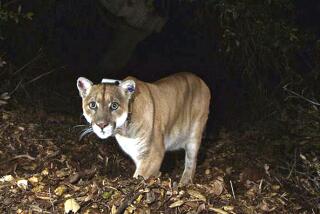Puma Expert to Assess Situation in Griffith Park
- Share via
An expert on mountain lions from UC Davis is arriving in Los Angeles today to help parks officials decide what to do about a big cat that has apparently found a home in Griffith Park.
Walter Boyce, the director of the UC Davis Wildlife Health Center, is being flown in at city expense and plans to tour the park.
“He’s here to help us train our employees and make sure that we do everything that is possible for us to do to keep people safe,” said Jane Kolb, spokeswoman for the city Department of Recreation and Parks.
Over the last four years, Boyce has overseen a comprehensive study of the mountain lion population of San Diego County. He has also served as a consultant to cities with cougar issues, such as Pacific Grove on the Monterey Peninsula.
The Griffith Park lion was spotted in late May at the intersection of Cromwell and Commonwealth avenues in Los Feliz, in a leafy residential neighborhood, Kolb said. Although a car killed a lion in the park in the late 1990s, wildlife experts say this is probably the closest a lion has been to downtown L.A. in several decades.
In April, the lion was seen several times on the north side of the park, near the old Toyon landfill. Before that, some equestrians had been trading stories of lion sightings.
Wildlife experts speculate that the cat either wandered into the 4,100-acre park from the Verdugo Mountains or from the western Santa Monica Mountains. The sightings prompted park officials to post dozens of signs near trailheads, warning hikers, bikers and other visitors of the possible presence of lions. City officials are working on translating the message into several languages.
Los Angeles City Council members have reacted with concern to the lion sightings. Earlier this spring, Councilman Tom LaBonge summoned parks employees to council chambers to brief officials, and he also pushed for Boyce to come. Boyce said Sunday he has been studying up on Griffith Park. “I’m going to try to give them my sense of the situation -- how did a lion get into the park and is there perhaps more than one lion in the area,” said Boyce. “Also, are there things they haven’t done that they should do to protect public safety?”
Mountain lions, like all large wildlife, are managed by the state Department of Fish and Game. The agency’s current policy toward them is “no harm, no foul,” meaning that lions are not killed just because one is seen by people.
The agency does have the option to kill any lion deemed a threat to public safety.
“The policy is never going to be perfect, but it’s a policy that most Californians feel comfortable with,” said Steve Martarano, an agency spokesman.
Martarano justified the policy by noting that mountain lion attacks on people are extremely rare. By his agency’s count, 14 people in California have been attacked since 1890, resulting in six deaths. The most recent was an Orange County man who was fatally mauled in Whiting Ranch Wilderness Park in January.
Boyce said many assumptions about mountain lions, also known as cougars or pumas, have been discredited in recent years. Once believed to be extremely shy and reclusive, lions have been found to live in higher densities than previously thought and seem increasingly willing to navigate urban areas to find habitat that provides plentiful deer and shelter.
The big question, said Boyce, is why the number of lion-human encounters appears to be increasing. One reason, he believes, is that people are more aware of lions and probably noticing cats that have been there all along. “But I’m beginning to think there’s more to it than that,” he said. “The fact that we’re seeing so many of those makes me wonder if we’re seeing an upswing in lion numbers for whatever reason.”
LaBonge said he hikes in Griffith Park several times a week and has devised his own plan in case of an encounter with the big feline: “I am going to stand tall, raise my hands, and yell: ‘Welcome to Los Angeles. Now go back to the Angeles National Forest.’ ”
More to Read
Sign up for Essential California
The most important California stories and recommendations in your inbox every morning.
You may occasionally receive promotional content from the Los Angeles Times.










